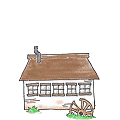hau Ricky,
The pawpaw is a true understory tree which means it is designed to start life in quite a bit of shade and it will be a slow grower for the first part of its life.
Pawpaw trees tend to be spindly looking in the wild since as they get older (from 3 to 4 years old) they start to reach for what sunlight they can find, which makes them grow long trunks to get the leaves up to the light.
Pawpaw trees are like most fruit trees and won't really start producing large quantities of fruits until they are nearing the 7 to 10 year window.
The best way to care for a pawpaw tree is to give it the same sorts of foods it finds in nature. That means
compost and leaf mold should be the main items you use for soil amendment.
Pawpaw trees love to have mycorrhizae, so giving your tree's roots those fungi will go a long way to getting more fruit over the years.
Don't bother with normal tree fertilizers unless you already have good mycorrhizal growth around and in your trees roots, the tree won't benefit much from your expenditure of money for fertilizer.
Pawpaw trees are usually found near streams in a canopy forest (at least in Arkansas we don't see them unless there is a stream or lake or pond nearby), they are tall (30+ feet) and the bottom is usually just trunk since the forest canopy keeps the light from reaching the soil.
If you try to force the growth rate, or "push" it to fruit faster than it wants to, you could end up with a dead tree.
Pawpaw trees seem to have a type of internal clock that determines their time to maturity.
These are similar to the wild American persimmon tree, which won't grow well unless there is a lot of decaying wood around their roots.
Both have certain conditions that must be met both for growth and for fruiting. I actually killed one of our persimmons by removing the heap of punky wood it was growing out of.
I raked the punky wood back (to do some trunk repair) and didn't put it back in place, two weeks later the tree leaves were turning brown so I gave the tree a small amount of multipurpose fertilizer, the tree died within five months of my removing the detritus.
Fortunately we have around 7 persimmon trees growing and now that I know their preferred conditions for thriving, I keep adding to their decaying wood needs by using the wind dropped branches from the woods along with piling up wetted leaves around the drip line of each tree.
Redhawk


